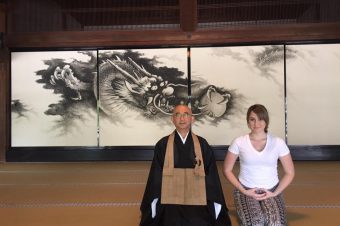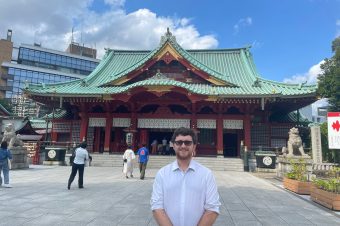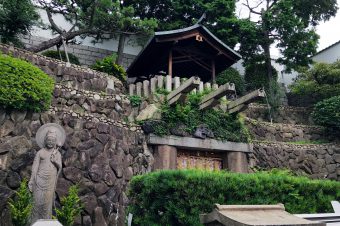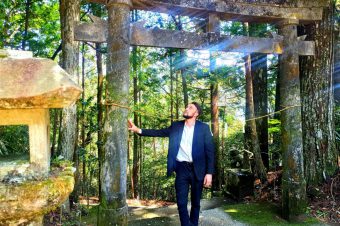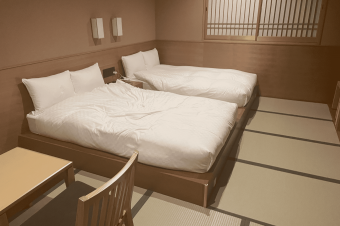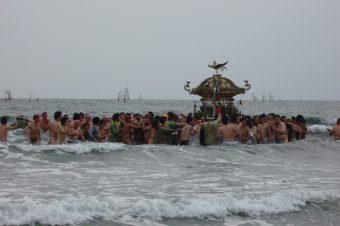
The streets of Yokohama are cornucopias full of foreign influences ranging from the Yokohama Christ Church (Catholic Yamate Church) to the Yokohama Foreign General Cemetery right down the street, to the American Yama Park. If you are in the Yokohama area, and are interested in a rather keen cultural experience, I suggest checking out Yokohama’s Chinatown area. Upon entering the area, I found myself in a maze of Chinese restaurants and souvenir shops. I was immediately welcomed by the aroma of freshly cooked Nikuman (Baozi in Mandarin) brushing at my nose and a vibrant flare of gold and red colors protruded at my sight. If you are interested in experiencing a piece of authentic Chinese history, culture, and architecture you should make your way to the Guan Di Miao (Kan-Tei-Byo) Temple. This Buddhist temple is a source of spirit and emotion for the Chinese people of Japan (Kakyo people), which links them to their ancestors and hometown. It is home of the Chief God Guan Yu, a military commander, who is also called “Lord Guan” or “The Holy King Guan.”

During the early stages of the Meiji Era, there were approximately a thousand Chinese people living in Yokohama. Chinatown was originally known as the “Yokohama Shinden” meaning newly developed rice field. More and more houses were being built—as part of a settlement—leading to the creation of Chinatown. The “Kan-Tei-Byo” began as a small temple in 1867 created by a Chinese person who brought a wooden statue of Guan Yu (Chinese General). Throughout the years the Kakyo people have displayed their dedication to their beliefs and tradition by successfully preserving this temple after it endured years of unforeseen destruction on multiple occasions. On this day, the temple stands firm in its place, as if it were never tampered with.
Based on my past experience in China and my current ventures in Japan I find myself constantly making comparisons between the two cultures. When arriving at the Kan-Tei-Byo temple I instantly noticed the architectural differences in structural design, color schemes, and interior décor between Chinese and Japanese temples. The interior design of a Chinese temple can be a bit overwhelming at first glance, whereas a typical Japanese temple is modest and easy on the eyes. A mere squint at the walls of Kan-Tei-Byo will not allow you to comprehend the amount of minute details it has. Even the main gate is decorated with outlandish ornaments. The layout of the temple’s inner room does not differ from that of Japan’s temples but at the end of the day it varies and depends solely on the god or deity being prayed to and worshiped.

My favorite part of visiting the temple was partaking in the worshiping of the gods, for 500 yen of course. I was given five sticks of incense to stick on incense thuribles located outside of the temple, in numerical order. This was part of a purification process needed before entering the temple. When entering the temple, I was instructed to pray to four different gods. I was told to kneel before each god, place my palms together and state my address, name, date of birth, and then proceed to pray (in my head).
First, in the center, I began with the “Guan Sheng Di Jun (Kan-Sei-Tei-Kun),” the deified name of Guan Yu. We pray to him in hopes that our business ventures will prosper, and we have success in our studies and examinations. Second, I headed to the left where I prayed to “Di Mu Niang Niang (Chi-Bo-Nyan-Nyan)”, the creator of all nature in the myth of creating the heaven and earth in ancient China. People worship this god for a healthy lifestyle and protection against evil and misfortune. The next god was located on the right. “Guan Yin Pu Sa (Kannon)”, is revered as a guardian god who protects people from bad fortune in this world and presents happiness. This god is worshipped for miraculous results in economic activities, raising children, admission to good schools, and marriage. I finally headed to the remaining god, in the right rear corner, “Fu De Zheng Shen (Fuku-Toku-Sei-Shin).” Commonly called “Lord Land”, this earthly deity is based on the belief for accumulation of property and huge harvests in the agrarian society in China. This god is believed to have the power of answering prayer with luck in money and safe preservation of property.

I was raised on religious practices, so prayer is something that I have done throughout my upbringing. What was special to me about praying in the Kan-Tei-Byo Temple was the guided process. Practicing prayer can be hard sometimes because you are speaking out of faith toward the god you are praying to, sometimes you may not know what you want to pray for. In the Kan-Tei-Byo you are provided a basis for what to pray for. Each prayer to the different gods touch upon very generic but extremely important aspects of the human life. Although I may not practice Buddhism it was nice to be able to reflect on specific details of my life including my studies, health, wealth, business endeavors, safety, and peace. The experience was quick and did not take much out of me. I would hope others feel compelled to partake in this practice–when in the Yokohama Area–not for the devotion to Buddhism but for the reflection of oneself.
